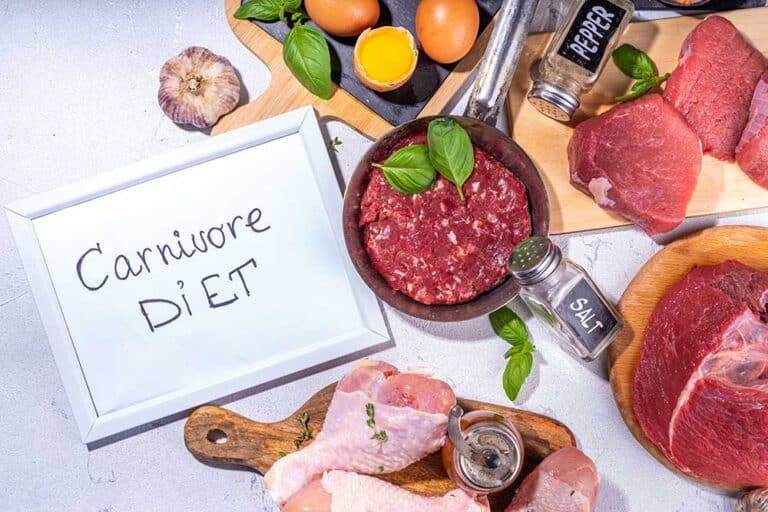Understanding the Carnivore Diet
Overview of the Carnivore Diet
The carnivore diet is a highly restrictive dietary regimen that consists entirely of animal products. It includes an assortment of meat, fish, and other animal-derived foods, while excluding all plant-based products. Unlike other low-carb diets like keto and paleo, which limit carbohydrate intake but still allow some plant-based foods, the carnivore diet aims for zero carbohydrates by eliminating all non-animal items. According to Healthline, this diet is controversial and may lack essential nutrients like fiber and plant compounds.
| Category | Allowed Foods | Prohibited Foods |
|---|---|---|
| Meat & Poultry | Beef, chicken, pork, lamb, turkey | None |
| Seafood | Fish, shellfish | None |
| Dairy | Low-lactose products like hard cheese, butter | High-lactose products like milk |
| Other Animal Products | Eggs, bone marrow, lard | All plant-derived foods |
Key Principles of the Carnivore Diet
The core tenet of the carnivore diet is the exclusive consumption of animal-based products. Here are the main principles:
-
Zero Carbohydrates: Unlike other low-carb diets, the carnivore diet excludes all plant foods to achieve zero carbohydrate intake (Healthline). This includes fruits, vegetables, grains, nuts, and seeds.
-
High Protein and Fat: The diet predominantly consists of meats, which are rich in protein and fat. Popular picks include beef, pork, chicken, and fish. Eggs and low-lactose dairy products like cheese are also allowed.
-
Exclusion of Fiber and Plant Compounds: By eliminating plant-based foods, the diet lacks beneficial nutrients like fiber and phytochemicals, which can impact gut health and overall nutrition (Medical News Today).
-
Simple Food Choices: The diet simplifies food selection by focusing solely on animal products. This makes it easier to plan meals but also limits variety. For more meal ideas, visit our section on carnivore diet recipes.
The carnivore diet has gained popularity due to proponents like Shawn Baker, an orthopedic doctor who advocates the diet for various health benefits despite the lack of controlled studies to support his claims (Healthline). For those considering this diet, it’s crucial to weigh potential carnivore diet benefits and risks, including possible carnivore diet side effects.
Foods Allowed on the Carnivore Diet
Understanding the foods allowed on the carnivore diet is essential to following it successfully. This diet comprises animal-based foods, so let’s dive into the selection of meats, fish and seafood, eggs, and dairy.
Meat Selection and Varieties
The carnivore diet emphasizes a variety of meats, making it a protein-rich choice. Here are some options:
-
Beef: Beef is high in protein, vitamins, and minerals. A 4-ounce serving provides 19 grams of fat, 265 calories, and 21 grams of protein (Carnivore Snax). Popular choices include steak, burgers, chuck roast, and organ meats such as liver and oxtail.
-
Chicken: Known for its lower fat content and versatility, chicken is a staple. A 4-ounce serving contains 187 calories, 4 grams of fat, and 35 grams of protein. Options include chicken breasts, thighs, wings, and drumsticks.
-
Pork: This includes cuts like pork chops, bacon, and ham, all rich in protein and fats.
-
Lamb: Includes lamb chops, leg of lamb, and ground lamb, providing a rich source of protein and fats.
Here’s a quick comparison of the nutritional values of different meats per 4-ounce serving:
| Meat Type | Calories | Fat (g) | Protein (g) |
|---|---|---|---|
| Beef | 265 | 19 | 21 |
| Chicken | 187 | 4 | 35 |
| Pork | 260 | 16 | 28 |
| Lamb | 294 | 23 | 25 |
Fish and Seafood Options
Fish and seafood are crucial components due to their high omega-3 fatty acid content and essential nutrients:
- Salmon: Rich in healthy fats and omega-3s.
- Sardines: Provide essential nutrients and omega-3 fatty acids.
- White Fish: Options like cod or halibut are lower in fat but high in protein.
- Shellfish: Such as oysters, clams, and shrimp provide a variety of nutrients beneficial for overall health.
These options fit well within the carnivore diet framework, offering diverse preparation methods.
Inclusion of Eggs and Dairy
Eggs and certain dairy products are permitted on the carnivore diet:
-
Eggs: Eggs are excellent for this diet. Each egg provides 75 calories, 7 grams of protein, and 5 grams of fat (Carnivore Snax). They can be enjoyed hard-boiled, soft-boiled, scrambled, or fried.
-
Dairy: Limited to low-lactose options like heavy cream and hard cheeses. These provide additional nutritional value while staying true to the diet’s principles.
| Food Item | Calories | Protein (g) | Fat (g) |
|---|---|---|---|
| Egg | 75 | 7 | 5 |
| Heavy Cream (1 oz) | 50 | 0.5 | 5 |
| Hard Cheese (1 oz) | 110 | 7 | 9 |
Explore more about approved foods and potential meal ideas in our articles on what can you eat on the carnivore diet and carnivore diet meal plan.
By understanding the variety and nutritional benefits of these foods, one can effectively follow the carnivore diet while enjoying a diverse menu.
Health Implications and Considerations
Nutritional Concerns of the Carnivore Diet
The Carnivore Diet emphasizes the exclusive consumption of animal products, which can pose significant nutritional challenges. This diet lacks fiber and beneficial nutrients found in plant-based foods, potentially leading to shortfalls in essential vitamins and minerals. According to Healthline, this can be especially problematic for individuals with chronic kidney disease or those who need to limit protein intake.
| Nutrient | Potential Deficiency | Source of Concern |
|---|---|---|
| Fiber | Lack of dietary fiber from fruits, vegetables, and grains | Digestive issues |
| Vitamins (C, K) | Absence of plant-based sources | Immunity, bone health |
| Antioxidants | No intake from fruits and vegetables | Cellular health |
| Phytonutrients | Missing from plant sources | Overall health protection |
Readers should always be aware of the importance of a balanced diet and perhaps consider complementing the carnivore diet with nutrient-rich carnivore diet supplements.
Impact on Gut Health and Digestion
The absence of fiber on the carnivore diet can have a significant impact on gut health. Fiber is essential for healthy digestion and protection against colon cancer and other health issues (Medical News Today). Without fiber, the digestive system may experience worsened conditions such as constipation, irregular bowel movements, and decreased gut flora diversity. This can lead to an imbalanced gut environment, affecting overall digestion and nutrient absorption.
Despite these concerns, advocates argue that the high protein content of the diet can lead to increased feelings of fullness and satiety. This could potentially aid in weight loss, improved nutrient intake, and enhanced athletic performance (People’s Choice Beef Jerky).
It’s crucial to balance the advantages of such satiation with the risks of fiber deficiency. People considering this diet should monitor their digestive health closely and consult with healthcare professionals to mitigate potential side effects.
By understanding both the nutritional concerns and the implications on gut health, individuals can make more informed decisions about their adherence to the carnivore diet and better navigate its potential impact on their overall health. For a clearer picture of the carnivore diet rules, it’s useful to explore a detailed carnivore diet meal plan and carnivore diet recipes.
Advocates and Studies on the Carnivore Diet
Shawn Baker and Proponents
Shawn Baker, an American orthopedic doctor, is one of the most vocal advocates of the carnivore diet. He claims that the diet can treat various health issues, though such assertions are not yet backed by controlled studies (Healthline). Proponents argue that the diet, which consists primarily of animal-based foods, aims for zero carbs and can lead to significant health improvements.
Supporters believe that human ancestral populations predominantly consumed meat and fish, and they blame today’s high rates of chronic diseases on high-carb diets (Healthline). This viewpoint contrasts with other popular low-carb diets like keto and paleo, which limit but do not entirely exclude carbohydrate intake.
Research and Studies on the Diet
Research on the carnivore diet is limited, but some studies have shown potential benefits for certain individuals. A study involving 2,029 participants who followed carnivore-style diets for nine to 20 months found significant health improvements among participants with type 2 diabetes. These individuals experienced reductions in their hemoglobin A1c levels, with 84% discontinuing oral diabetes medications and 92% discontinuing insulin use (Health.com).
In another study conducted in 2021, participants reported substantial reductions in their body mass index (BMI) after transitioning to the carnivore diet. This suggests that very low-carb diets like the carnivore diet may promote weight loss due to their high protein content and elimination of carb-rich foods.
| Study Focus | Key Findings |
|---|---|
| Diabetes Management | Significant reductions in hemoglobin A1c levels; 84% discontinued oral medications; 92% discontinued insulin use |
| BMI Reduction | Substantial reductions in BMI observed among participants |
For those considering starting the carnivore diet, it’s important to weigh the potential benefits and drawbacks. While the diet may lead to improved nutrient intake and enhanced athletic performance, it also carries potential risks such as high saturated fat intake, increased risk of certain cancers, and higher cholesterol levels. For more detailed information, refer to our articles on carnivore diet side effects and carnivore diet results.
Comparing the Carnivore Diet to Others
Contrasting with Keto and Paleo
The carnivore diet is gaining popularity as a more extreme version of low-carb eating plans. However, it differs significantly from other popular diets like keto and paleo.
| Diet Type | Carbohydrate Restriction | Allowed Foods | Excluded Foods |
|---|---|---|---|
| Carnivore | Zero carbs | Meat, fish, eggs, limited dairy | Plants, grains, legumes |
| Keto | Very low carbs (5-10% of total calories) | Meat, fish, eggs, dairy, low-carb vegetables, nuts | High-carb foods, grains, most fruits |
| Paleo | Moderate carbs (from natural sources) | Meat, fish, eggs, vegetables, fruits, nuts | Processed foods, grains, legumes, dairy |
Ketogenic Diet
The keto diet emphasizes a very low carbohydrate intake to maintain a state of ketosis, where the body burns fat for fuel instead of carbs. Foods included are meats, fish, eggs, dairy, and low-carb vegetables. Unlike the carnivore diet, keto allows small amounts of carb-rich foods (Health.com).
Paleolithic Diet
The Paleo diet encourages eating natural, unprocessed foods our ancestors likely consumed. This includes meats, fish, eggs, vegetables, fruits, and nuts while excluding refined or artificial products, dairy, grains, legumes, and potatoes (Harvard Health Publishing).
Benefits and Drawbacks Compared
Like any diet, the carnivore, keto, and paleo approaches have their own benefits and drawbacks.
| Diet Type | Benefits | Drawbacks |
|---|---|---|
| Carnivore | High protein, potential weight loss, simple to follow | Lacks fiber, essential nutrients, high in fat, possible negative gut health issues (Healthline) |
| Keto | Effective for weight loss and managing epilepsy, promotes fat burning | Difficult to maintain, possible nutrient deficiencies, may negatively impact heart health (Healthline) |
| Paleo | Encourages whole foods, may improve blood sugar levels and reduce inflammation | Restricts several food groups, may be expensive, possible difficulty sustaining over time (Harvard Health Publishing) |
Potential Drawbacks of the Carnivore Diet
The carnivore diet’s restriction to purely animal-based foods can lead to nutritional gaps, particularly in fiber and other essential nutrients typically obtained from plant-based foods. These deficiencies can impact gut health and lead to other health complications. Additionally, its high fat and cholesterol content may pose risks to individuals with preexisting conditions, such as chronic kidney disease. For more on health concerns, see our article on carnivore diet side effects.
Benefits of the Carnivore Diet
Advocates argue that eliminating plant foods can simplify meal choices and potentially lead to weight loss due to the high protein content and absence of carbohydrate-rich foods. Diets like keto have demonstrated similar short-term weight loss effectiveness (Health.com). However, the long-term sustainability and health impacts of such extreme dietary restrictions remain a topic of debate.
When considering transitioning to the carnivore diet, you might find it helpful to refer to our grocery shopping guide and detailed diet plan. To explore whether this approach aligns with your health goals, consult with a healthcare professional and review current research and studies on the diet’s impact.
For those interested in practical aspects such as recipes, check out our collection of carnivore diet recipes and success stories on carnivore diet results.
Starting the Carnivore Diet
Embracing the carnivore diet requires a strategic approach to grocery shopping and a smooth transition to the new dietary plan. This section outlines essential tips and guidelines for those looking to start the carnivore diet effectively.
Grocery Shopping Guide
When following the carnivore diet, it is crucial to stock up on the right foods that align with the dietary principles. The diet primarily focuses on animal-based foods, which consist of various meats, fish, poultry, eggs, and some dairy products.
Meat Selection and Varieties
- Beef: High in protein, vitamins, and minerals. A 4-ounce serving provides 19 grams of fat, 265 calories, and 21 grams of protein (Carnivore Snax)
- Pork: Rich in protein and nutrients. A 4-ounce serving offers 270 calories, 16 grams of fat, and 30 grams of protein (Carnivore Snax)
- Poultry: Includes chicken, turkey, and duck. Opt for skin-on varieties for higher fat content.
Fish and Seafood Options
- Salmon: Provides essential omega-3 fatty acids.
- Sardines: Nutrient-dense and rich in calcium.
- Shrimp: Low in calories but high in protein.
Inclusion of Eggs and Dairy
- Eggs: Affordable and versatile source of protein.
- Dairy Products: Focus on higher fat options like cheese and heavy cream.
To make your shopping more practical, consider organizing your grocery list based on these categories.
| Category | Example Foods |
|---|---|
| Meat | Beef, pork, lamb, goat, venison |
| Poultry | Chicken (thighs/drumsticks), turkey, duck |
| Fish and Seafood | Salmon, sardines, shrimp, sea bass |
| Eggs | Chicken eggs, duck eggs |
| Dairy | Cheese, heavy cream, butter |
For more specific ideas, see our extensive carnivore diet foods list.
Transitioning to the Carnivore Diet Plan
Transitioning to the carnivore diet involves gradually adjusting your meal plans and lifestyle.
Step-by-Step Guide:
- Phase Out Non-Allowed Foods: Gradually reduce and then eliminate vegetables, fruits, grains, nuts, and seeds.
- Increase Protein and Fats: Enhance your meal plans with a variety of meat, fish, poultry, and eggs. Be mindful to include higher-fat options to maintain energy levels.
- Hydrate: Drink plenty of water, and include electrolytes if needed.
- Monitor Health Markers: Pay attention to potential side effects and discuss any significant changes or concerns with a healthcare provider.
A sample meal plan can help beginners navigate their daily meals.
| Meal | Example |
|---|---|
| Breakfast | Bacon and eggs, coffee with heavy cream |
| Lunch | Grilled salmon, side of shrimp |
| Dinner | Ribeye steak, beef liver |
| Snacks | Hard-boiled eggs, cheese sticks |
For a more detailed approach, visit our carnivore diet meal plan.
Adopting the carnivore diet can offer various health benefits to some individuals (read more), but it’s essential to transition thoughtfully to avoid common pitfalls and to maximize the diet’s potential.
- About the Author
- Latest Posts
Johnnie D. Jackow Sr., the founder and CEO of Total Body Fitness, Worldwide, has a long-standing career in the fitness industry. He began as a certified personal trainer in the mid-90s and soon after authored his first weight loss book in 1998. This led to the launch of Total Body Fitness, Nationwide in the USA at the same time. Johnnie gained recognition as the fitness guru of his time, running infomercials on local TV late at night in Houston, Texas. Over the years, he has helped more than 40,000 individuals from all over the world achieve their health and fitness goals. With over 60,000 hours of documented training in integrative functional medicine, he completed his PhD in human physiology in 2010. His primary objective is to assist people in reaching their health and fitness goals through alternative approaches rather than relying solely on conventional medicine and pharmaceutical drugs. Today, with almost three decades of experience under his belt, Johnnie continues to be a leader in health and fitness.








